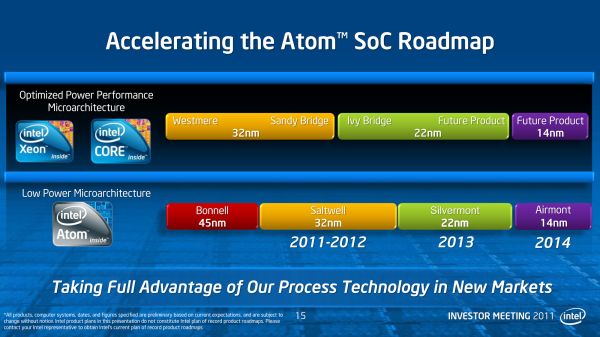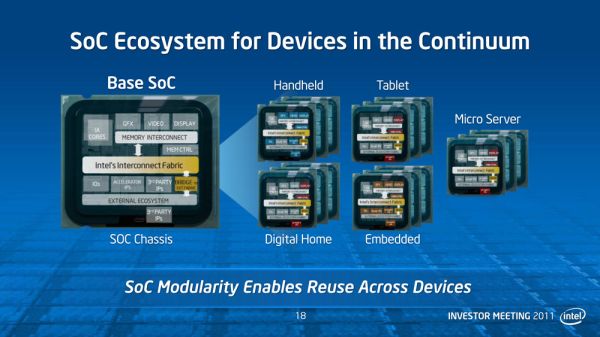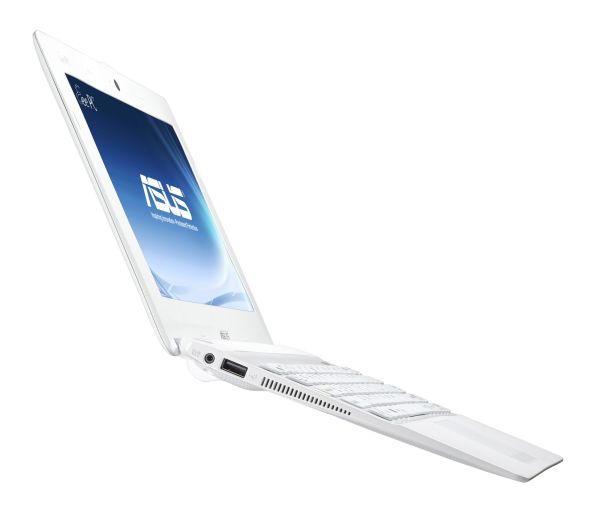The Ultrabook: Meet the New Thin and Light Intel Notebook
by Anand Lal Shimpi on May 31, 2011 12:01 AM EST- Posted in
- Laptops
- CPUs
- Intel
- Atom
- Haswell
- Computex 2011
- Trade Shows
- Ultrabook
Where Does This Leave Atom?
When Haswell hits in 2013, Intel will also update the Atom line to introduce the recently announced Silvermont architecture. As I speculated publicly before, based on Intel's hint to me five years ago that Atom would remain in-order for five years, I'm expecting Silvermont to be Intel's first Out-of-Order Atom.

When Atom was introduced, its microprocessor architecture was unlike anything we'd seen from Intel in years. It looked more like a modern take on the Pentium rather than a P6/Conroe derivative. That was nearly five years ago, so what do we expect Silvermont to look like? I'd say it might look a lot like a modern, ultra low power take on Conroe. Perhaps a limited Out-of-Order execution core, only a 3-wide front end and a number of other limitations to keep its power in check.
In the sub-10W range Intel is going to use Atom specifically for fanless designs - the next generation of netbooks as well as tablets. Cedar Trail is Intel's 32nm Atom platform which we've talked about already, which will be used in netbooks such as ASUS' newly announced EeePC X101:
Medfield is the ultra mobile version of Atom, destined for handsets and tablets, and at the show we should finally see a Honeycomb (Android 3.0) tablet running the SoC. Unfortunately with NVIDIA Tegra 2 based tablets moving to Android 3.1 already, and Medfield designs not due out until later this year I'm wondering if that may be too little too late.

Expect more coverage on Intel's announcements at the show as we come by them.















33 Comments
View All Comments
StormyParis - Tuesday, May 31, 2011 - link
Intel has a history of failing at anything where they don't have a huge headstart (ie, anything non x86, or non purely process driven: Itanium, networks, wireless, DGX, RISC... basically, anything non Flash and non x86, and even x86 they managed to mess up a few times.They finally threw in the diversification towel and went all-in on x86. I'm very unclear about what advantages x86 has apart from Intel's fabs. MS dramatically dropping the ball in the phone/tablet space didn't help them at all. MS trying to avoid a catastrophe by going ARM doesn't either. Even if MS finally manages to put together something believable in the phone/tablet space, it won't be an Intel exclusive.
My new Desktop is a $350 E-350, and is plenty powerful for what I do with it. I'm guessing next year ARM will be at that level of power (basically, playing videos on one screen, office stuff on the other, very light gaming), and it will be a good time to take a long hard look at whether paying $150+ for a Windows license really makes sense.
I think the weak link int the ARM food chain is Linux: no games, too fragmented, too experimental still, bad documentation. If a good strong and above newb-friendly version of Linux could emerge as a good all-rounder, ARM's chances would be even better. If the Linux camp doesn't wake up quickly, we'll end up with Windows on ARM, which will be... sad.
JarredWalton - Tuesday, May 31, 2011 - link
Generally speaking, all modern CPUs are now RISC, but the x86 processors have an x86 decoding front end that translates the CISC instructions into RISC. Intel did this first way back in the P6 days. Of course, we also have all the SSE, MME, and other extensions (not just from Intel -- all the other CPUs have specialized instruction sets as well for certain work), so I'm not sure how valid calling anything "RISC" is these days.I'd also take pretty strong exception with the assertion that Intel has "failed" at networks and wireless; my experience is that both their WiFi and NIC solutions are slightly better than the competition.
Then we get to the part where you say that an E-350 desktop is "plenty powerful for what you do". I suppose that's great for you, but having used E-350 and a lot of other systems, E-350 would be way down my list for a desktop system. I might use if for an HTPC, but anything more demanding than that and there are far better options. Llano at least is looking pretty good in initial testing, though.
Wilco1 - Tuesday, May 31, 2011 - link
CISC CPUs are NOT RISC, as this is about the instruction set. And they are not the same internally either. CISCs always carry the extra overhead of complex variable length instruction decoders, large micro code ROMs and micro sequencers, extra logic to deal with read/modify/write instructions etc.It is for this reason that you can have an Out-of-order RISC (Cortex-A9) which is not only several times smaller than an Atom, but also much faster while using far less power. That's the difference between RISC and CISC.
Penti - Tuesday, May 31, 2011 - link
There's plenty of documentation, games and coherency in GNU/Linux but it is largely so in the embedded and mobile space as ARM doesn't target desktops.So a GNU/Linux platform with Gstreamer (Gstreamer and OpenMAX decoders), PulseAudio, GCC toolchain, libraries or middleware such as Clutter, Qt, Android and EGL/DRI/OpenGL ES support does plenty well in the phone, tablet and embedded market with multimedia, applications, user friendliness and games. You have players such as MeeGo, WebOS, Android and low-level infrastructure oriented LiMo. What you don't have and never will have is a consumer GNU/Linux distro that will run on everything from desktop oriented netbooks, desktops and server to phones and tablets. But you already has great games for the GNU/Linux platforms through the mobile-variants. There's no reason you can't use the same tools and API's for full size aka desktop games. For that matter Microsoft will never run Windows (NT) on phones. 8 for ARM I'm sure won't be for desktop users and I'm even more sure you won't be able to install it yourself. Intel however was rather set on running GNU/Linux on x86 tablets and smartphones. That might change now when their partner Nokia decided to go with Microsoft and downsize a profitable company, but I'm pretty sure they don't base their business on that. Different platforms should exist just fine tomorrow too. It's the normal consumers and hardware manufacturers that decides if Windows 8 tablets/smartbooks stick. Just being Windows based and building on ribbon won't do it by it self.
Freddo - Tuesday, May 31, 2011 - link
Looking forward to the fanless Cedar Trail netbooks a lot.I hope there will be at least one "quality" model that is released with metal, instead of just feeling like a cheap plastic toy. Oh, and support for HDMI, of course.
SteelCity1981 - Tuesday, May 31, 2011 - link
"Silvermont to look like? I'd say it might look a lot like a modern, ultra low power take on Conroe."So that will mean by 2019 the Atoms should have similar performace as the first gen Core I series. :)
soydeedo - Tuesday, May 31, 2011 - link
Does anyone know the model of the laptop in the second picture on the very first page of the article? The picture below the new Padfone.stonedatheist - Tuesday, May 31, 2011 - link
Yes I do, seeing as how I just ordered one :) it's the Asus Transformer inserted into its keyboard dock.soydeedo - Tuesday, May 31, 2011 - link
Thanks a lot for the help, and enjoy your new toy. =)Very sleek indeed. ASUS isn't playing around these days.
Kepe - Tuesday, May 31, 2011 - link
Yep, the URL to the picture is http://images.anandtech.com/reviews/tablets/ASUS/E... so it isn't that hard to guess what it is ;)